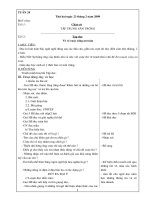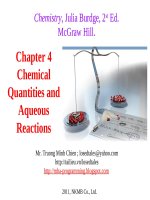Bài soạn Chapter 24 Transition Metals and Coordination Compounds
Bạn đang xem bản rút gọn của tài liệu. Xem và tải ngay bản đầy đủ của tài liệu tại đây (3.37 MB, 46 trang )
Chapter 24
Transition
Metals and
Coordination
Compounds
2011, NKMB Co., Ltd.
Chemistry, Julia Burdge, 2
st
Ed.
McGraw Hill.
Mr. Truong Minh Chien ;
/>
2
Gemstones
•
the colors of rubies and emeralds are both due
to the presence of Cr
3+
ions – the difference lies
in the crystal hosting the ion
Some Al
3+
ions
in Al
2
O
3
are
replaced by
Cr
3+
Some Al
3+
ions
in
Be
3
Al
2
(SiO
3
)
6
are replaced by
Cr
3+
Chemistry, Julia Burdge, 2
nd
e., McGraw Hill.
3
Properties and Electron Configuration of
Transition Metals
•
the properties of the transition metals are similar to each
other
and very different to the properties of the main group metals
high melting points, high densities, moderate to very hard, and
very good electrical conductors
•
in general, the transition metals have two valence
electrons – we are filling the d orbitals in the shell below
the valence
Group 1B and some others have 1 valence electron due to
“promotion” of an electron into the d sublevel to fill it
form ions by losing the ns electrons first, then the (n – 1)d
Chemistry, Julia Burdge, 2
nd
e., McGraw Hill.
4
Atomic Size
•
the atomic radii of all
the transition metals
are very similar
small increase in size
down a column
Chemistry, Julia Burdge, 2
nd
e., McGraw Hill.
5
Ionization Energy
•
the first ionization
energy of the
transition metals
slowly increases
across a series
•
third transition series
slightly higher 1
st
IE
trend opposite to
main group elements
Chemistry, Julia Burdge, 2
nd
e., McGraw Hill.
6
Electronegativity
•
the electronegativity of
the transition metals
slowly increases across a
series
except for last element in
the series
•
electronegativity
slightly increases down
the column
trend opposite to main
group elements
Chemistry, Julia Burdge, 2
nd
e., McGraw Hill.
7
Oxidation States
•
often exhibit multiple oxidation states
•
vary by 1
•
highest oxidation state is group number for 3B to 7B
Chemistry, Julia Burdge, 2
nd
e., McGraw Hill.
8
Coordination Compounds
•
when a complex ion combines with counterions to make
a neutral compound it is called a coordination
compound
•
the primary valence is the oxidation number of the
metal
•
the secondary valence is the number of ligands bonded
to the metal
coordination number
•
coordination number range from 2 to 12, with the most
common being 6 and 4
CoCl
3
⋅6H
2
O = [Co(H
2
O)
6
]Cl
3
Chemistry, Julia Burdge, 2
nd
e., McGraw Hill.
9
Coordination Compound
Chemistry, Julia Burdge, 2
nd
e., McGraw Hill.
10
Complex Ion Formation
•
complex ion formation is a type of Lewis acid-
base reaction
•
a bond that forms when the pair of electrons is
donated by one atom is called a coordinate
covalent bond
Chemistry, Julia Burdge, 2
nd
e., McGraw Hill.
11
Ligands with Extra Teeth
•
some ligands can form more than one
coordinate covalent bond with the metal atom
lone pairs on different atoms that are separate enough
so that both can reach the metal
•
chelate is a complex ion containing a
multidentate ligand
ligand is called the chelating agent
Chemistry, Julia Burdge, 2
nd
e., McGraw Hill.
12
Chemistry, Julia Burdge, 2
nd
e., McGraw Hill.
13
EDTA
a Polydentate Ligand
Chemistry, Julia Burdge, 2
nd
e., McGraw Hill.
14
Complex Ions with Polydentate Ligands
Chemistry, Julia Burdge, 2
nd
e., McGraw Hill.
15
Geometries in Complex Ions
Chemistry, Julia Burdge, 2
nd
e., McGraw Hill.
16
Common Ligands
Chemistry, Julia Burdge, 2
nd
e., McGraw Hill.
17
phenanthroline
H
2
N
NH
2
ethylene diamine
O
O
-
O
-
O
oxalate
Chemistry, Julia Burdge, 2
nd
e., McGraw Hill.
[Fe(en)(NH
3
)
4
]Cl
3
•
Fe is +3
•
3 moles of AgCl would form
Fe
N
N
NH
3
NH
3
NH
3
NH
3
H
2
C
H
2
C
H
H
+3
Chemistry, Julia Burdge, 2
nd
e., McGraw Hill.









